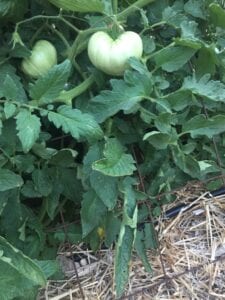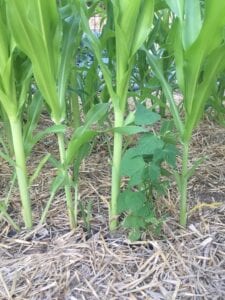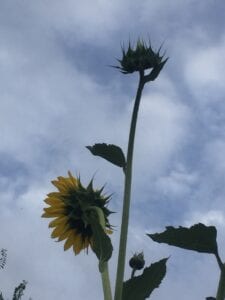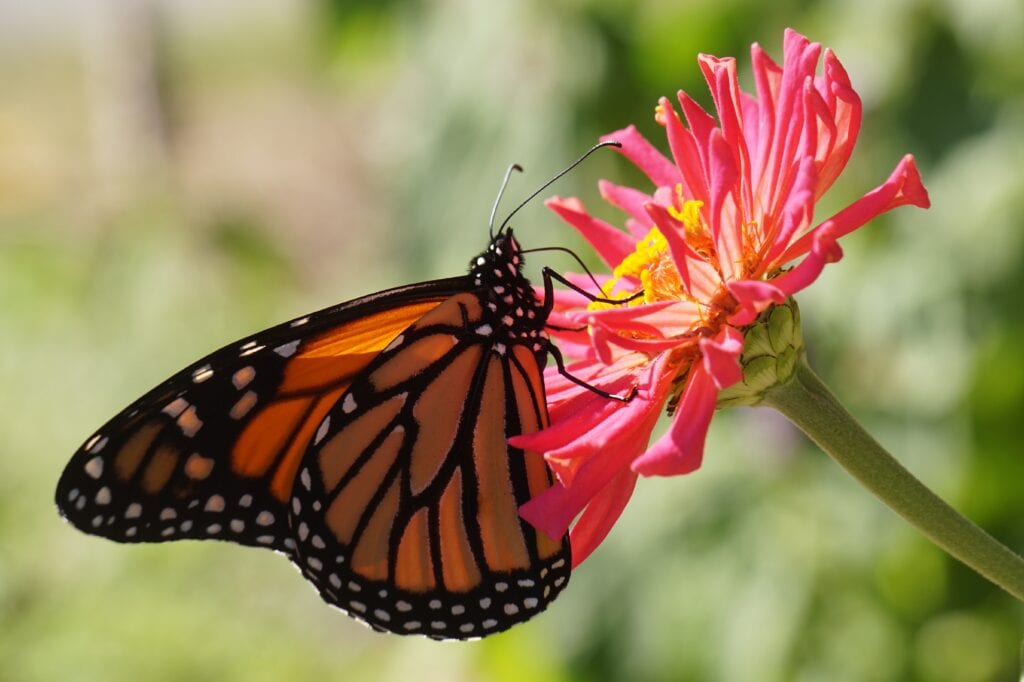We are anticipating 90º-105º temperatures for the next 5-7 days! Here in New Mexico we have dry heat — meaning our actual temperature is high but because of the low humidity, around 10%, we can escape to the shade and feel like the temperature is 10-15º cooler. Whether it’s actually cooler or if it is just the fact that there’s no solar radiation, it makes a huge difference in comfort level.
That’s true for people, pets, and plants.
In my garden I take advantage of several principles to conserve water, cool down the blazing summer heat, and keep my garden flourishing.
Planting distance:
If you have ever purchased seed packets, they will usually say to thin the seedlings out once established to ‘just-so-many’ inches apart. Here in NM I usually ignore those numbers. I find, especially for crops where the fruit/vegetables a
re above ground, I can get away with planting much closer than the recommended spacing. This way the plants’ leaves help to shade the surrounding plants and the ground. Hanging out with their neighbors and keeping all healthier and happier.
Mulch:

I mulch my garden heavily all the way up to the plants. This helps keep moisture in the dirt. Most plants like to keep their “feet” cool. That doesn’t mean soggy and wet, just comfortable. For most vegetables you do not want the ground to totally dry out. Usually I mulch with old straw hay. At the beginning of the season the straw may be between 1-2 inches thick. By the end of the summer, it is much thinner because the natural breakdown of the organic matter is at play. In the winter, to keep moisture in the ground and keep the dirt microbiome alive, I mulch with the leftover hay and burlap coffee bags to limit evaporation. Mulching is a good thing. And speaking of good things, did you know that the microbiome in the dirt may double as an antidepressant?
Water:
Traditionally in NM, farmers flood irrigate their fields. We have water ways, called acequias that bring water from the Rio Grande to the farming areas. Acequias is another word for ditch. There are doors in the ditch that farmers access once a week and flood their fields. I don’t use the acequias near my home. Instead I use a drip irrigation system. That is a major watering hose with smaller tubes coming off it. The tubes have perforations in them which look like someone took a razor blade every 12” along the tube and cut a 1/2” perforation. When the water is turned on, the hoses drip water. It’s a great way to get water where it is needed. It creates a slow drip and allows water to soak deep into the ground. I generally water once a day during the hottest part of the summer. The drip irrigation will run for 60-90 minutes. Very little water is wasted and the plants really thrive. I keep the hoses under the mulch as much as possible to help reduce wear and tear from the sun and to keep the water as cool as possible in the hoses — even if I water in the early evening.
Pollinator-friendly Plants:
I have a section of my vegetable garden where I threw seeds along the drip irrigation lines 2 years ago. I leave these plants to do whatever they want because they are NM wildflowers. Many reseed/or re-grow each spring. They are great for attracting bees and other pollinators to the garden. The Butterfly Effect may be in play — those pollinators may even create a bit of a breeze to help cool the garden. 🙂
If you plan to garden, learn about the area where you live. Watch the yard around your home for about a year to see when the area is in sun, partial sun, full shade or if there are areas where water collects. This way you can take into account your micro-climates and grow plants that are likely to thrive there.


Great info as always! I like the idea of planting closer not farther apart. Makes sense.
Thank you, Sara. The spacing certainly makes for happy plants.